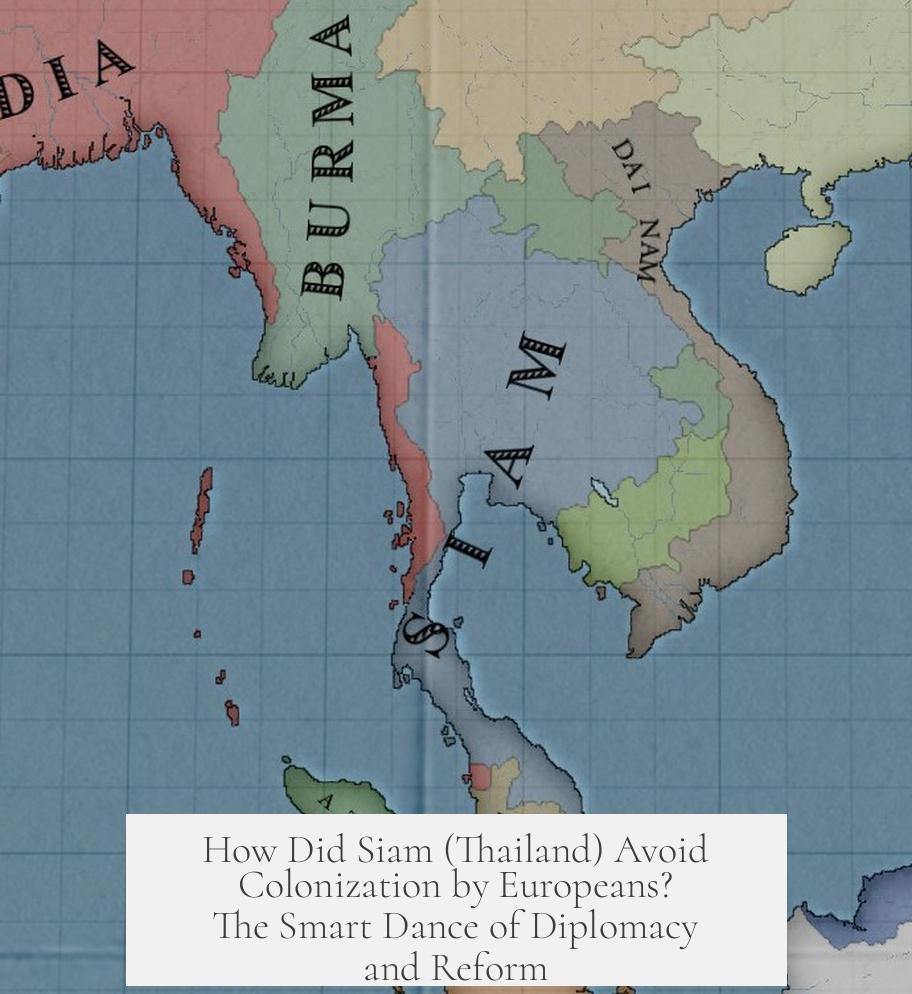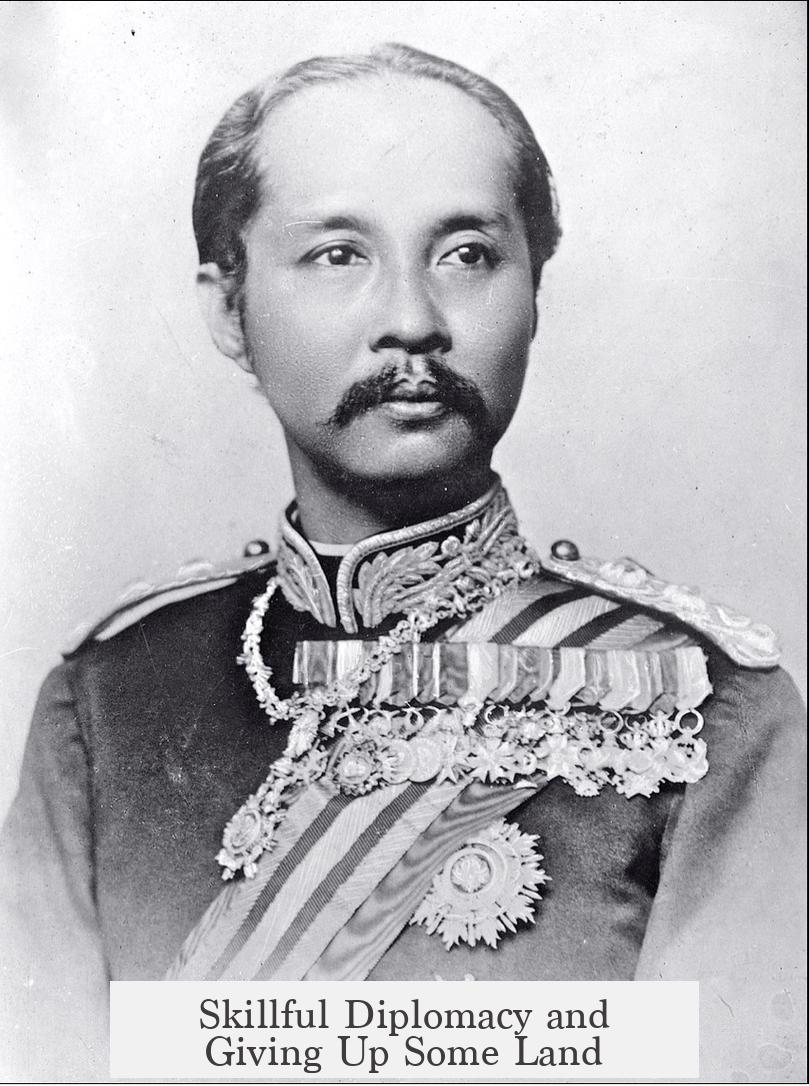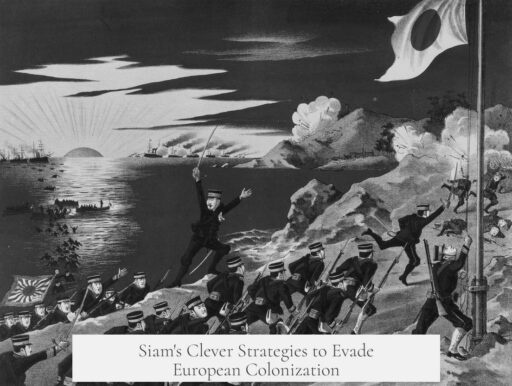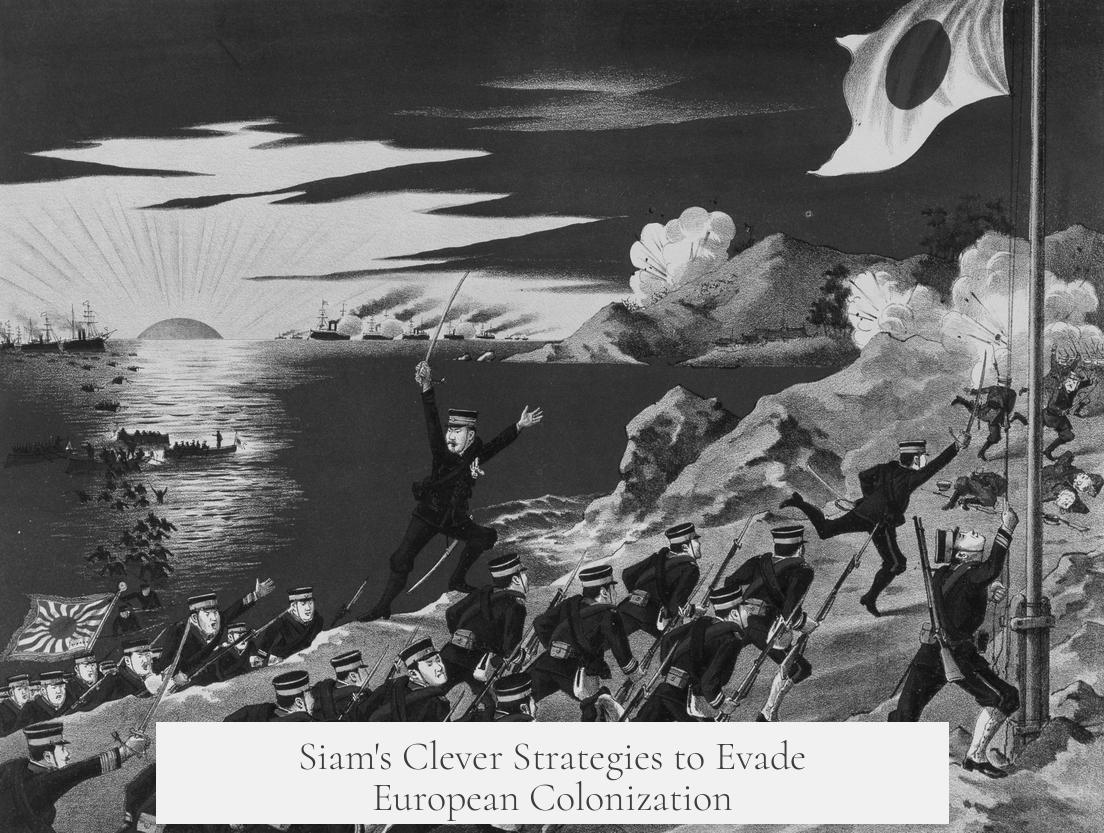Siam (modern-day Thailand) avoided European colonization through a blend of diplomacy, strategic concessions, reforms, and its unique geopolitical position. It served as a buffer state between British and French colonial powers, adopting political reforms that mirrored European states and using skilled diplomacy to preserve its core territory.
Siam’s location was crucial. Positioned between British-controlled Burma and the Malay Peninsula to the west and French Indochina to the east, Siam acted as a neutral zone. Both Britain and France agreed to maintain Siam as a buffer state. This agreement reduced tensions and prevented direct conflict between these rival colonial powers, ensuring Siam’s continued independence. Its geographical role made invasion less appealing for either side, averting war in a region rife with competition.
The Siamese monarchy implemented key reforms to strengthen the state internally. Kings centralized power in Bangkok, replacing fragmented regional control with a unified administration. They set fixed borders to clarify territorial sovereignty. A modern military was developed, modeled on European standards. Siam promoted the Thai language and culture to create national unity. These changes helped Siam appear as a modern nation-state, making European colonization less justifiable in diplomatic terms because it was seen as a legitimate sovereign entity.
King Mongkut (Rama IV) exemplified strategic diplomacy. Facing European demands, he ceded peripheral territories now part of neighboring countries such as Cambodia and parts of Malaysia. These territorial concessions appeased colonial powers while preserving Siam’s central domains. This demonstrated his negotiation skill and keen understanding of European politics through research. The concessions bought Siam time and security without surrendering its core.
Additionally, Siam adeptly navigated military alliances. It procured arms from both Britain and France, encouraging rival colonial powers to support its defense against each other. This balance in arms procurement and alliances ensured Siam had sufficient military strength and deterred any single European power from aggressive moves.
| Key Factors | Details |
|---|---|
| Geopolitical Role | Buffer state between British and French empires |
| Political Reforms | Centralized rule, fixed borders, modern military |
| Diplomatic Strategy | Territorial concessions and negotiation skills |
| Military Alliances | Armed by rival powers to maintain independence |
- Siam’s position between colonial powers was vital to its survival.
- Reforms aligned Siam with European nation-state models.
- Diplomatic concessions preserved the kingdom’s core territory.
- Balancing arms and alliances prevented domination by one power.
How Did Siam (Thailand) Avoid Colonization by Europeans? The Smart Dance of Diplomacy and Reform

Siam, known today as Thailand, dodged colonial rule by Europeans through a clever mix of geopolitical strategy, savvy diplomacy, bold reforms, and playing great power rivals against each other. This blend made Thailand stand out in 19th and early 20th-century Southeast Asia, where most neighbors fell under European control. Curious how Thailand pulled off this feat? Let’s unpack the story piece by piece.
The Buffer State Between Giants
Imagine you’re stuck between two big, bickering siblings trying to grab the last cookie. You could either get squashed or play them off each other. Siam chose the latter.
During the 1800s, the British expanded southward through Burma and the Malay Peninsula, while the French colonized Indochina (modern Vietnam, Cambodia, Laos). Siam sat right in the middle of these expanding empires. Since both colonial powers hated the idea of going to war over land, they agreed to keep Siam as a neutral buffer state between them.
This setup wasn’t just a lucky coincidence. European powers realized overlapping their territories here could spark conflict. So, they effectively signed an unspoken “no touch zone” over Siam to avoid war.
“The British and the French agreed not to invade Siam and instead use it as a buffer state to prevent war.”
This positioning played a huge role in Siam’s survival. Positioned as a no-go zone they both respected, Siam bought precious time and space to maneuver politically.
Modernizing Like a European Nation-State
Survival meant more than just geography; Siam needed to *look* like a proper country in the eyes of Europeans. They knew the colonial powers used “civilization” as a justification for domination.
Starting with King Mongkut (Rama IV) and his son, King Chulalongkorn (Rama V), Siam radically reformed itself. It abandoned its older, somewhat loose political structure for a centralized government based in Bangkok.
- They drew clear and fixed borders to present Siam as a sovereign nation with recognized limits.
- Siam built a modern, professional military to impress and deter outsiders.
- The administration standardized the Thai language and legal codes to promote national unity.
These reforms made Siam *familiar*—something European countries could relate to. This familiarity robbed colonial powers of their usual excuses. It was tough to claim Siam was “uncivilized” or needed “protection” when it acted like a modern state.
Skillful Diplomacy and Giving Up Some Land

While Siam retained core sovereignty, it didn’t shy away from smart compromises. King Mongkut and later King Chulalongkorn didn’t blindly contest European advances. Instead, they conceded some peripheral territories which are parts of modern Cambodia, Burma, Vietnam, and Malaysia.
This might sound like surrender, but it was a calculated move to appease the British and French, ensuring the heartland remained independent. It’s like giving up a pawn in chess to keep the king safe.
Such territorial concessions weren’t signs of weakness. They were strategic sacrifices in a bigger game where maintaining independence was paramount.
Playing both Sides: Arms and Alliances
Here’s a twist: Siam didn’t just stay neutral—they mingled diplomatically with both the French and British, their colonial rivals.
Legend has it that Siam asked the British to arm them against the French threat in Indochina. Meanwhile, it sought weapons from the French to counterbalance British pressure from India and Burma.
This balancing act turned Siam into a game of political “keep away” where neither colonial power could easily justify invasion. Siam was too well-armed and diplomatically connected to become an easy target.
Why Should We Care About This Escaping Act?
Siam’s story is a masterclass in pragmatic leadership, cultural savvy, and political acumen. It shows survival isn’t about raw power alone but *strategy*. Instead of fighting colonial powers head on or surrendering entirely, Siam rewrote the rules.
For countries watching how to defend sovereignty, Siam remains a fascinating example of achieving independence without bloodshed, unlike many of its neighbors.
What Can We Learn Today?

Thailand’s success teaches these lessons:
- Adaptation is key: Tailor your approach to match shifting realities around you.
- Flexibility beats rigidity: Smart concessions can save the bigger picture.
- Diplomatic balancing: Owning relationships with multiple parties keeps options open.
- Modernization matters: Being respected prevents exploitation.
In a world full of complex power plays, these timeless strategies still ring true.
In Conclusion
Siam avoided European colonization because it served as a strategic buffer state, embraced deep political reforms to align with European standards, skillfully traded land concessions, and balanced rival colonial powers through military alliances and diplomacy.
While the story isn’t about flamboyant military victories or sweeping revolutions, it illustrates how subtle, shrewd governance can reshape the destiny of entire nations. Siam’s unique diplomatic dance kept its independence intact and shaped the Thailand we know today.
So next time you hear about Thailand’s rich culture and history, remember: its independence is the result of brilliant strategy and bold leadership rather than mere geography or luck.
How did Siam serve as a buffer state between European powers?
Siam was positioned between British and French colonies in Southeast Asia. Both powers agreed not to invade it, using Siam to prevent direct conflict. This agreement kept Siam independent from colonization.
What political changes helped Siam avoid colonization?
Siam’s kings centralized power in Bangkok and created fixed borders. They built a modern military and promoted a unified national identity. These reforms made Siam appear more like European states.
How did King Mongut’s territorial concessions aid Siam’s independence?
King Mongut ceded some border territories to Britain and France. These concessions satisfied the powers and preserved the core of Siam. His diplomacy was key to maintaining sovereignty.
Why was Siam able to get arms from both Britain and France?
Siam played the colonial powers against each other. It asked Britain for arms to protect against France, and France for arms to protect against Britain. This balanced approach helped keep Siam armed and independent.




